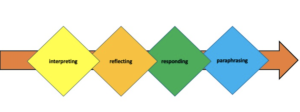Effective Mentoring Techniques
Active Listening
The Red Seal Occupational Standard for the trade Plumber states the following about the need for improving our communication skills;
Oral Communication[1]
Plumbers require good oral communication skills to interact with colleagues, apprentices, supervisors, suppliers, inspectors, clients and other tradespersons when co-ordinating work, resolving problems, and ensuring safety.
Working with Others[2]
During the course of a workday, plumbers must interact with others such as co-workers, suppliers, clients, and other trades.
Given all the communication we do, some would think that we do a good job both in speaking and listening. But in fact, most of us are not as good as we think we are, and the research would suggest that we retain approximately 30% of what we hear.
This means that when we are having a conversation with our supervisors, other journeypeople, or our apprentices, they will only remember three minutes of our ten-minute conversation.
Conversely, when we are being given directions or being presented with new information, we aren’t hearing the complete story either. What if the 30% of what we hear turns out to be the least important piece of the whole message?
Listening is a skill and like any skill, it gets better. Listening is a skill that everyone will benefit from and it will improve efficiency and productivity. It will improve your ability to influence, negotiate, and persuade others. In addition, developing our listening skills will help us avoid misunderstandings and conflicts.
Being someone who actively listens means more than just hearing what others have to say. When you are hearing someone, you are not necessarily paying attention to the content of what is being communicated. You are primarily just haring words. This occurs most often when we are distracted within the conversation. Distraction can be present in many different forms, but the most common form of distraction comes from our mobile devices. Trying to pay attention to two forms of communication at the same time will cause you to listen to one more than the other. Typically, this means that we will ‘tune out’ the one who’s speaking because we have placed a higher priority onto the content of our devices rather than the content of the one speaking.
Active listening can be described as having four basic components.

Interpreting
When we are interpreting someone’s communication, especially verbal communication, we are actively decoding what is being said. In this decoding, we are searching for context, meaning, and bias. Ironically this is where most people will interrupt the one who is speaking because the listener has already determined (decoded) the content of the message.
Reflecting
Reflection is close to the paraphrasing phase in the sense that the listener can repeat back what they have just heard in order to seek clarification. However, a larger and more critical component of reflection is in the ability to suspend the urge to interrupt and think through what the other person is saying. Taking a small amount of time to discern the content of the conversation will help minimize misunderstandings and lessen frustration on the speaker’s part due to being constantly interrupted. It will also help you to come up with some good questions to use if you need clarification. Asking questions such as, ‘can you repeat what you just said’, ‘is this what you mean?’ can vastly improve the communication process.
Responding
Responding to other’s communication can be done with both verbal and non-verbal cues. Body language, facial expressions, head nodding, positioning of the arms, and types of breathing (sighs, long-drawn breaths) are all examples of response mechanisms. When combined with the previous act of reflecting you can choose your words carefully if the context demands a certain level of diplomacy. Simply looking the person in eye while they talk may prove to be a positive act of responding.
Paraphrasing
This one act may prove to be the most important in developing great listening skills. When you think that you have captured the thoughts and context of the conversation a great way to demonstrate active listening would be to say, ‘what I’m hearing you say is…’ or ‘let me repeat back to you what I just heard you say so that I know I got it right’. It is always good to summarize what you have just heard, especially if getting the message wrong translates into you having to repeat tasks or if it leads to unsafe acts.
For further reading on the importance and practice of active listening, refer to the article at Skills You Need – https://www.skillsyouneed.com/ips/active-listening.html
Key Takeaways
BCcampus, Trades Access – Common Core: Line B Employability Skills, Competency B-3: Use Interpersonal Communication Skills. 2015 http://open.bccampus.ca/find-open-textbooks/
eCampusOntario; Communication for Business Professionals. 2018. https://ecampusontario.pressbooks.pub/commbusprofcdn/
Red Seal Essential Skills Outline, Plumber (2016), Employment and Social Development Canada.
Skills You Need Article (website) – https://www.skillsyouneed.com/ips/active-listening.html
[1] Red Seal Occupational Standard, Plumber:2015 – http://www.publicentre.esdc.gc.ca/
[2] ibid

